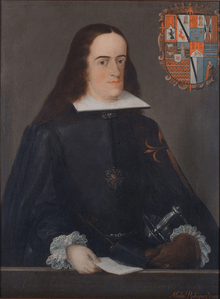Francisco Fernández de la Cueva, 10th Duke of Alburquerque
| Don Francisco Fernández de la Cueva Duke of Alburquerque Caballero de Santiago | |
|---|---|
 | |
| Viceroy of New Spain | |
|
In office 27 November 1702 – 14 January 1711 | |
| Monarch | Philip V |
| Preceded by | Juan Ortega |
| Succeeded by | The Duke of Linares |
| Personal details | |
| Born |
17 November 1666 Genoa, Italy |
| Died |
28 June 1724 (aged 57) Madrid, Spain |
| Religion | Catholic |
| Signature |
|
Francisco V Fernández de la Cueva y Fernández de la Cueva, (Genoa, Italy, 17 November 1666 – Madrid, Spain, 28 June 1724) was the 10th Duke of Alburquerque, Grandee of Spain, a Knight of the Order of the Golden Fleece since 1707, and viceroy of New Spain, Viceroy of Mexico, from 27 November 1702 to 14 January 1711.
He was the nephew of Francisco IV Fernández de la Cueva y Enríquez de Cabrera – Colonna, (* Barcelona, 1618/1619 – † Madrid, (Palacio Real) 27 March 1676), 8th Duque de Alburquerque and many other lesser titles, also a Viceroy of New Spain, (1653–1660), and Viceroy of Sicily, (1667–1670), and the son of the 9th Duke of Albuquerque, and many other lesser titles, the cadet brother of the 8th Duke, and inheritor of the titles, Melchor Fernández de la Cueva y Enríquez de Ribera-Colonna, (* Madrid, 2 March 1625 – † Madrid 12 October 1686).
His father, Melchor, the 9th Duke, had married in 1665 his niece Ana Rosolea Fernández de la Cueva y Díaz de Aux, the 3rd marquise of Cadreita, Navarre, daughter of the 8th Duke of Albuquerque Francisco IV Fernández de la Cueva and Juana Francisca Díez de Aux y Armendáriz, herself daughter of Lope Díez de Armendáriz, Viceroy of Mexico (1635–1640).
This Spanish – Equatorian, Francisco Fernández de La Cueva y Fernandez de la Cueva, 10th Duke, was thus family connected through paternal and maternal links with 2 former Viceroys of New Spain, Viceroys of México, his uncle Francisco IV, the 8th Duke of Albuquerque and Lope Díez de Armendáriz.
He was captain general of the Kingdom of Granada and captain general of the coast of Andalusia.
His administration
Upon his arrival in Veracruz he was informed of the establishment there of a French trading post dealing in black slaves. The French had received a concession of ten years. The new viceroy gave his approval.
He arrived in Chapultepec in November, 1702 and made his formal entry into Mexico City on 8 December 1702. He was a fervent support of the Bourbon monarchy and of King Philip V of Spain, and he worked in New Spain to suppress any kind of discontent that could result in support for the Habsburg party.
This viceroy's administration was known for its luxury and magnificence. On 6 January 1703 the palace guards in the viceregal palace appeared in uniforms of the French mode for the first time, three-cornered hats and all. This attracted much attention, and fashions at the court and beyond quickly followed along the same lines. This was a fashion of luxury, starkly contrasted with the poverty of the majority of the people.
Marriage
He married in Madrid, 6 February 1684, 18-year-old Juana de la Cerda y de Aragón-Moncada, (* Puerto de Santa María, 27 March 1664 – † Madrid 28] June 1724, a daughter of Juan Francisco II Tomás Lorenzo de la Cerda 8th Duke of Medinaceli, 8 Duke of Alcalá de los Gazules, a Knight of the Order of the Golden Fleece, and many other lesser titles.
Their first son, inheritor of the titles, was named Francisco VI Fernández de la Cueva y de las Cerda, (* Madrid 28 September 1692 – † Hortaleza, 23. June 1757), 11th Duke of Alburquerque and many other lesser titles, who married in 1734 Agustina Ramona de Silva y de los Ríos, a.k.a. María Agustina de Silva y Mendoza, deceased 10 years later, a daughter of Juan de Dios de Silva y Mendoza,(1672–1737), 10th Duque del Infantado, and Maria Teresa, a daughter of Francisco Domingo Gutiérrez de los Ríos, from Cordoba and Ambassador in France.
Military affairs
Fernández de La Cueva repaired and expanded the armada of Barlovento (coast guard) so that it could attack pirates. He devoted much of the armed forces to dislodging the English and Dutch from the coast of the Seno Mexicano (Gulf coast). He sent reinforcements and supplies to Saint Augustine, Florida, which was besieged by the English. He confiscated the property of the English and Dutch, and used the proceeds to fend off their incursions. He worked to protect the newly established Jesuit missions in California.
He also worked hard to provide financial aid to the Bourbons in the Spanish War of Succession. He demanded that the clergy turn over one tenth of their rents to the government. The archbishop strongly objected. When Fernández de La Cueva's term in office was extended, in gratitude he remitted two million pesos to the Crown. To raise this money, he resorted to shady methods, such as selling government positions. His remissions to Spain were so large that the government found itself unable to pay many police and other employees, and they were laid off. The streets and highways became infested with brigands.
Crime and rebellion
In 1701 the Tribunal de la Acordada (literally, Court of Agreement) was founded. It received this name as the result of a proposal agreed to by the Audiencia. It was an organization of volunteers intended to capture and quickly try bandits. From its creation to the beginning of the Mexican War of Independence in 1810, the Acordada delivered 57,500 verdicts to 62,850 accused. Of those, 35,058 were freed, 888 were hanged, 1,729 were whipped; 19,410 were sentenced to prison for one or two years and 263 to labor on public works; 777 were banished to camps in the north, and the remainder were sent on to regular judges. Three hundred forty died in hospitals and 1,280 in prison.
In 1704 the viceroy suppressed a rebellion of the Pima Indians in Nueva Vizcaya, using bloody methods. The Indians were terrorized and submitted, but in the long run this was a bad result for the Spanish. The Indians became distrustful and resisted evangelization and integration into the society of the viceroyalty.
Reputation
On April 23, 1706 the Villa de Alburquerque (Albuquerque) was founded. On 12 October 1709 San Francisco de Cuéllar (now the city of Chihuahua) was founded. Also in 1709 the Church of Santa María de Guadalupe was established.
In spite of his faults, Fernández de La Cueva had a reputation as an affable, moderate and capable governor who maintained tranquility and security in the viceroyalty. He turned over the government around January 1711 to his successor till around August 1716, Fernando de Alencastre Noroña y Silva, duque de Linares, marqués de Valdefuentes (c. 1641, Spain—3 June 1717, Mexico City) wa He also served as viceroy of New Spain, from 15 January 1711 to 15 August 1716.
Afterwards, he returned to Spain during 1711, dying in Madrid in June 1724, aged 57.
References
Sources
- García Purón, Manuel (1984). México y sus gobernantes (in Spanish). 1. Mexico City: Joaquín Porrua.
- Orozco Linares, Fernando (1985). Gobernantes de México (in Spanish). Mexico City: Panorama Editorial. ISBN 968-38-0260-5.
- Orozco Linares, Fernando (1988). Fechas Históricas de México (in Spanish). Mexico City: Panorama Editorial. ISBN 968-38-0046-7.
- Hobbs, Nicolas (2007). "Grandes de España" (in Spanish). Retrieved 15 October 2008.
- Rosenmüller, Christoph. Patrons, Partisans, and Palace Intrigues: The Court Society of Colonial Mexico, 1702–1710.Calgary: University of Calgary Press, 2008.
- (Spanish) "Acordada, La," Enciclopedia de México, v. 1. Mexico City, 1988.
- (Spanish) "Fernández de La Cueva Enríquez, Francisco," Enciclopedia de México, v. 5. Mexico City, 1988.
| Government offices | ||
|---|---|---|
| Preceded by Juan Ortega |
Viceroy of New Spain 1702–1711 |
Succeeded by The Duke of Linares |
| Spanish nobility | ||
| Preceded by Melchor Fernández de La Cueva |
Duke of Alburquerque 1686–1724 |
Succeeded by Francisco Fernández de La Cueva |
- ↑ Simmons, Marc (20003). Hispanic Albuquerque: 1706-1846. Albuquerque: University of New Mexico Press. p. 45. ISBN 0-8263-3160-2. Check date values in:
|date=(help)

